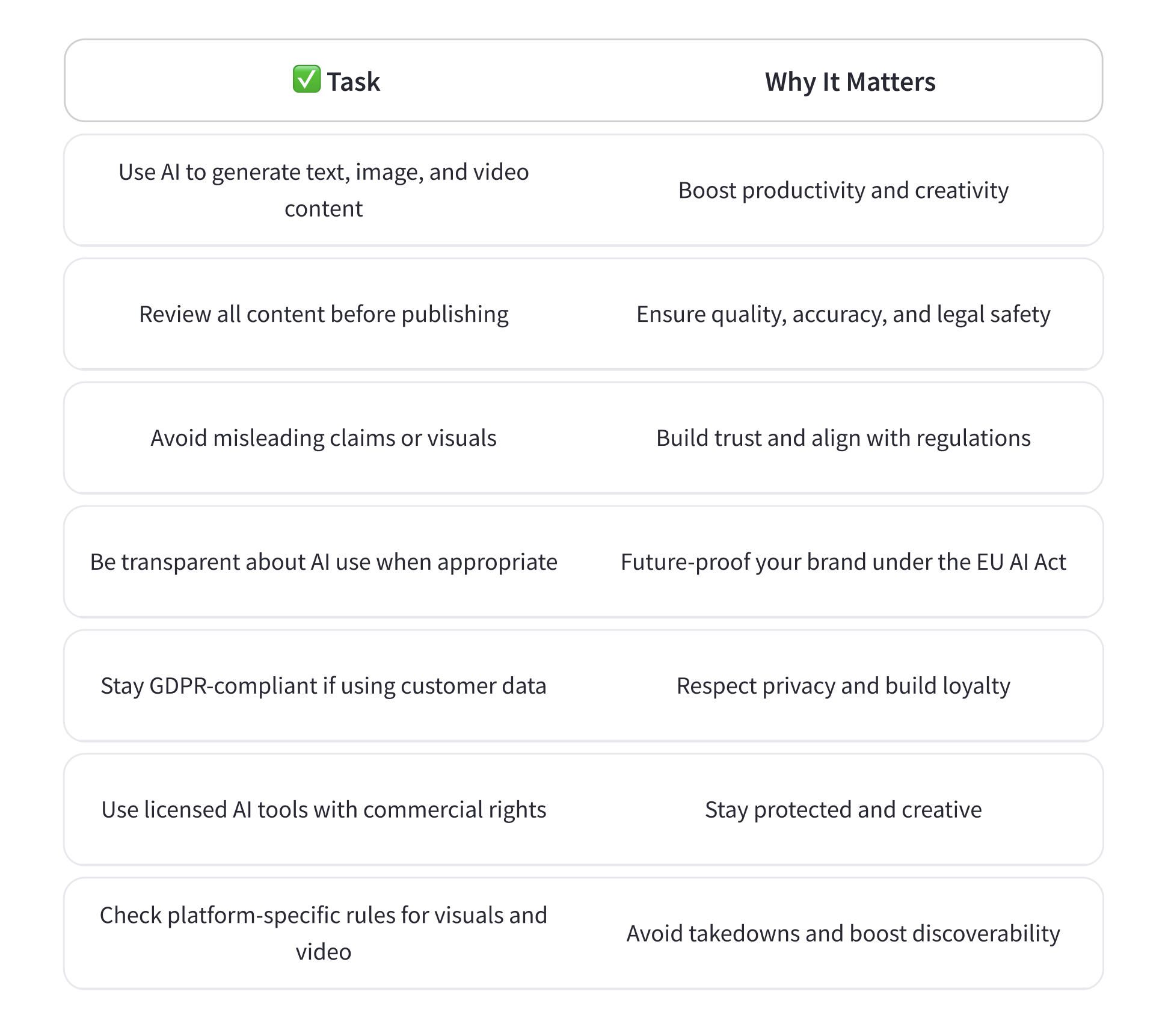Artificial intelligence is opening up new creative possibilities in e-commerce. Whether you're generating product descriptions, marketing copy, product images, or even videos, AI can save time, boost quality, and scale content creation like never before.
But as with any powerful tool, success comes from using it smartly—and legally. In Norway, AI-generated content is allowed in e-commerce, and businesses that understand the rules can use it with confidence.
Here’s what you need to know to make the most of AI content in your store—while staying compliant, transparent, and ahead of the curve.
There are no laws in Norway that prohibit the use of AI-generated content in online stores. In fact, businesses are encouraged to explore automation and smart content strategies to enhance user experience and streamline operations.
you’re in the clear. Just follow some smart practices to ensure your content also aligns with existing consumer protection and data privacy rules.
Many e-commerce businesses now use AI to create:
These formats can be powerful marketing tools—but here’s how to stay on the right side of the law in Norway:
Under the Marketing Control Act, AI-generated visuals must not mislead consumers about:
💡 Positive spin: You can absolutely use creative visuals to inspire, demonstrate use cases, and support storytelling—just make sure they don’t misrepresent the actual product.
Even though AI-generated images may seem “original,” they might still raise IP concerns if the output closely resembles known designs, logos, or media.
Also, if you're using AI to edit or generate images based on real people (e.g., customer photos or models), be cautious of image rights and consent.
If you publish content on third-party platforms (like marketplaces or social media), check:
💡 Platforms like Amazon or Meta may flag AI-generated imagery if it appears inauthentic or violates ad policies. Use AI tools that produce natural, high-quality results—and always label visual effects if necessary.
4. Future-Proof with the EU AI Act
The upcoming EU AI Act (which Norway will adopt through the EEA agreement) will introduce clearer requirements for synthetic image and video content, particularly when it could mislead viewers.
This will likely include:
💡 Get ahead: If your content is fully AI-created, consider disclosing this proactively. It shows leadership and builds trust with your audience.
Norway’s Marketing Control Act ensures fairness and trust in all commercial communication. When using AI, this means:
Why it’s a benefit: These rules protect customers and elevate your brand’s credibility. By reviewing AI-generated content before publishing, you reinforce both compliance and quality.
💡 Pro Tip: Use AI to create content, but always give it a final human touch. This adds quality control and keeps your store aligned with legal standards.
There’s currently no legal obligation in Norway to label content as “AI-generated.” However, transparency is quickly becoming a best practice—especially under the upcoming EU AI Act.
How you benefit: Being open about using AI builds customer confidence. It shows that your company is modern, responsible, and committed to ethical content creation.
For example, you might say:
“Some of the content, images, or videos on this page were created with the help of AI tools to improve accuracy and consistency.”
If you’re using AI in any way that touches customer data—such as personalised content, dynamic pricing, or targeted visuals—then GDPR rules apply.
The good news? Most platforms and AI tools are increasingly GDPR-aware and privacy-friendly.
💡 Tip: If your AI isn't using personal data, then GDPR doesn’t apply. But if it is, make sure your privacy policy reflects how AI is involved—and give users control where needed.
AI-generated content isn’t automatically protected by copyright unless it involves meaningful human input. But you can own or commercially use it by:
💡 Pro tip: AI is a tool—not a final product. Combine it with your creativity and voice for maximum originality and ownership.
If you also sell through platforms like Amazon, Finn.no, or Shopify, be sure to check their policies around:
Most platforms welcome high-quality content—AI included—as long as it’s clearly presented, accurate, and doesn't violate IP or trust policies.
Here’s a quick summary of how to stay compliant, build trust, and get the most from AI in your online store:

In short: Norway’s legal environment supports innovation while protecting consumers. By understanding a few key areas—truthful marketing, privacy, transparency, and content rights—you can unlock the full power of AI while building a strong and compliant brand.
AI isn’t just a time-saver—it’s a creative partner and growth engine when used responsibly.
This article is for informational purposes only and does not constitute legal advice. While it reflects current legal principles and best practices relevant to e-commerce in Norway, it is not a substitute for advice from a qualified lawyer. If you have specific legal questions or concerns—especially regarding copyright, GDPR, or platform risk—we strongly recommend consulting a legal professional.